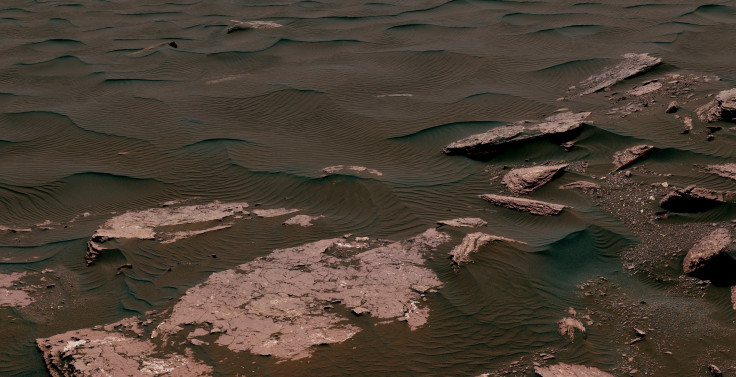Wind On Mars: NASA Curiosity Rover Studies Sand Dunes On Planet

NASA’s Curiosity rover is digging Mars, with the goal of helping scientists understand the wind and earth on that planet. The robot took a sample of sand from an area of rippled dunes and is carrying it in its hand as it climbs uphill to its next target on the layered mountain Mount Sharp.
Have sand, will travel. I'm toting a sample for analysis from rippled Martian dunes as I climb farther up Mt Sharp https://t.co/Mq9zU5Gr6E pic.twitter.com/ski64hAcs1
— Curiosity Rover (@MarsCuriosity) May 4, 2017
The rover scooped up the dark sand with its arm to cap off its investigation of the dunes and has partially analyzed it, according to NASA’s Jet Propulsion Laboratory. One thing the experts are looking for is how the grains are organized, to find out “whether Martian winds sort grains of sand in ways that affect the distribution of mineral compositions, which would have implications for studies of Martian sandstones.”
Read: NASA Makes a Little Friend for the Mars Rover
Wind is complicated on Mars. The linear dunes the rover just visited, with peaks running in lines, are only about a mile uphill from crescent-shaped dunes Curiosity studied immediately before. One difference in the conditions is that the way wind moves across the linear dunes is more complex than how it moves at the crescents, with more wind coming down Mount Sharp’s slope into the closer linear dune field.
“Among the questions this Martian dune campaign is addressing is how winds shape dunes that are relatively close together, on the same side of the same mountain, into different patterns,” NASA said. “This two-phase campaign is the first close-up study of active dunes anywhere other than Earth.”
The space agency is using images taken on Mars to follow wind movements, as the wind detection part of the weather instrument on the rover’s mast wasn’t working when Curiosity landed on Mars in 2012.
Crescent-shaped dunes are the most common type on both Earth and Mars, according to the U.S. Geological Survey. But in addition to those and linear-shaped dunes, there are other types, including star-shaped dunes.
Curiosity’s dune mission comes after it inspected the plains around the base of the mountain and learned that “ancient Martian lakes offered conditions that would have been favorable for microbes if Mars has ever hosted life,” NASA said. The mountain’s base “accumulated as sediment within ancient lakes billions of years ago.”
As it scales Mount Sharp, the rover is looking for clues about what happened as Mars dried up.
When Mars was wetter, it also had a more hospitable atmosphere. Today that air is thin and it largely carbon dioxide, but recent research suggests it was perhaps three times thicker in its past. As Mars lost its atmosphere, it turned cold and dry.
In addition to learning about the evolution of the Red Planet and its potential for supporting life, studying its climate change also gives scientists clues about what Earth may be able to expect as its own atmosphere and environment goes through changes.
See also:
© Copyright IBTimes 2025. All rights reserved.





















